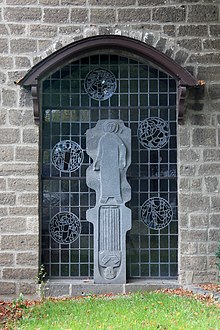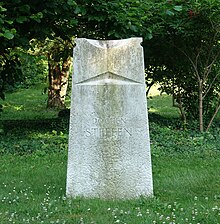Günther Oellers
Günther Oellers (born January 27, 1925 in Linz am Rhein ; † May 13, 2011 there ) was a German sculptor .
Life
Günther Oellers, who grew up in his hometown Linz, began to occupy himself with modeling and working in wood and stone at a young age.
After returning home from military service and taking private lessons in arts and crafts, he was able to begin studying at the old Cologne factory school in 1947 . In 1951 he continued his training at the Académie de la Grande Chaumière in Paris a. a. continued with Ossip Zadkine . In Paris he also made the acquaintance of the Romanian sculptor Constantin Brâncuși .


Oellers created numerous works of stone, wood and bronze for public spaces, such as outdoor sculptures for the Horchheimer Höhe residential area in Koblenz , for the police headquarters in Koblenz, for the German Bundestag and the Federal Chancellery in Bonn, for the Euskirchen art mile , but also as furnishings of churches, such as the altar built on a podium made of serpentine and marble of the Peace Christ Church in Bonn-Bad Godesberg, built in 1977, the two churches in Linz / Rhine, the St. Francis Church in Koblenz (1969) or the Catholic one Church in Norheim / Nahe.
In Berlin-Lichterfelde , Günther Oellers' column of prisoners has stood at the former satellite camp of Sachsenhausen concentration camp on Wismarer Strasse since 2000 . The pillar of community has stood in front of the Essen regional court since 2003 , in Neutraubling near Regensburg a memorial harmony, reconciliation, conversation between people across all borders .
Since 2017, two new sculpture paths with works by Günther Oellers have been built: in his hometown Linz on the Rhine and in the RWW waterworks Mülheim-Styrum (on loan from the Kurt Sandweg Foundation).
Oellers very often named his sculptures with a plural: The Walking , The Dancing , The Kneeling or The Sitting (1972). In his work, he was concerned with the original “being with”, the “we”, the block formed into a simple gesture with a monumental sign language. Wolf Schön wrote about this work:
"That which connects the spiritually, which is able to undo the isolation of the individual, manifests itself in elementary forms of expression of the human body - the very own field of activity of the sculptor who, when he means the spirit, cannot do without the chisel."
Oellers cultivated connections with representatives of literature , music and science : Heinrich Böll , HG Adler and Bernd Alois Zimmermann were among his friends. His wife Edith Oellers-Teuber and their daughter Edith Oellers are painters; the son-in-law Jörg Eberhard is also a painter; his son Adam C. Oellers is an art historian and was deputy museum director in Aachen , another daughter is an art historian.
In 1972 Günther Oellers was together with Joseph Beuys , Heinrich Böll, Georg Meistermann , Walter Warnach a. a. Founder of the "Free International University for Creativity and Interdisciplinary Research".
In 1985/86 Günther Oellers had a teaching position at the Düsseldorf Art Academy .
Oellers, who liked to work with the brittle basalt lava from the Eifel , is also known for his “sound stones” or “singing stones” made from this material: the sculpture, struck with a stick, reacts like a monumental tuning fork ; the stone, which is chipped at differently massive places, responds with a short, dry tone of different height.
Works by Oellers have been shown in numerous exhibitions, including in Cologne, Bensberg, Bonn, Essen, Düsseldorf, Amsterdam, Berlin, Mainz and Trier. Works can be found in many private collections as well as in the Landesmuseum Mainz, Roentgen-Museum Neuwied, Rheinisches Landesmuseum Bonn and Museum Stiftung Schloss Moyland.
literature
- Parallel - encounter in art and life. Pictures by Edith Oellers-Teuber - sculptures by Günther Oellers, with contributions by Franz Joseph van der Grinten, Frank Günter Zehnder and Albert Gerhards, Bensberg 1994
- Günther Oellers - sculptures and sculptures in stone, wood and bronze from five decades, Bonn 1998
- Marion Schnapp-Enderes, “Freedom to Duty” - The sculptor Günther Oellers. Free works, dissertation University of Bonn 2005
- Two generations of artists. Günther Oellers, Edith Oellers-Teuber, Edith Oellers, exhibition catalog Roentgen-Museum Neuwied 2012
- There were artists in the city, exhibition catalog Kunstverein Linz / Rhein 2020
Web links
- Information on the Oellers family of artists
- Literature by and about Günther Oellers in the catalog of the German National Library
- The Linz artist couple Günther Oellers and Edith Oellers-Teuber. A life for art . City of Linz am Rhein, 2019
- "Freedom to Duty". The sculptor Günther Oellers. Free works. - Dissertation by Marion Schnapp-Enderes, University of Bonn, 2006 (PDF file, 41 MB)
Individual evidence
- ↑ Uwe Danker , Jens-Peter Steffen (ed.): Jochen Steffen, Schleswig-Holsteinischer Geschichtsverlag, Malente 2018, p. 690
- ^ Günther Oellers: Die Sitzenden (1972) , Bonn-Heiderhof. (World of form)
| personal data | |
|---|---|
| SURNAME | Oellers, Günther |
| BRIEF DESCRIPTION | German sculptor |
| DATE OF BIRTH | January 27, 1925 |
| PLACE OF BIRTH | Linz on the Rhine |
| DATE OF DEATH | May 13, 2011 |
| Place of death | Linz on the Rhine |

